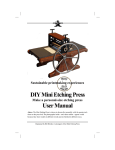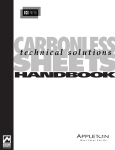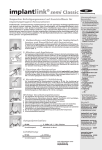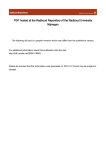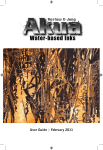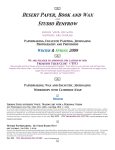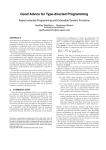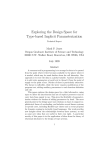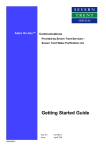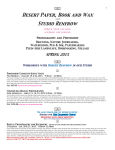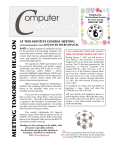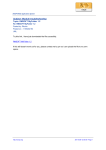Download DIY Mini Press - PrintmakingWorld
Transcript
Fun fine art printmaking DIY Mini Press Core with fitted hardwood hood Threaded hex screw, 5/32” X 1” Allen wrench, 5/64 Allen wrench, 1/8 Custom Philips screw hex bit, 1/4” Open, box end wrench combination, 5/16” Custom barrel cap nut, 5/32” Custom barrel cap nut, 3/16” Side piece, Active Side piece, Passive Wheel, 8” diameter, welded steel Press bed with rack PVC Chase cut for 5 X 7” plates, 1/4” thick Set screw for wheel hub, 1/4” Threaded rod cross-tie pieces with rollers, jamb nut (2) Felt blanket, sizing catcher, 6 X 12” Felt blanket, roller blanket, 6 X 12” 1 3/4” Diameter badge blank , brass Rembrandt’s Chocolates User Manual Email for current prices [email protected] Originated by Bill Ritchie, Co-designer of the Mini Etching Press DBA Emeralda Works Mailing address: 500 Aloha #105 Seattle WA 98109 www.printmakingworld.com Email: [email protected] Bill Ritchie, 2004 20 © 2013 Bill Ritchie If viewing this on screen, know that the pages are laid out for double-sided printing and folded, so use the page numbers. Mini Press replacement parts Experience real printmaking DIY Mini Press Make a personalsized etching press This is the Seattle Workshop Edition Working Proof Originated by Bill Ritchie, Co-designer of the Mini Etching Press Copyright 2013 DIY Mini Press Seattle Workshop Edition Greetings Welcome to the Mini Art Gallery, site of a DIY Mini Press making Workshop. The gallery is owned by Bill and Lynda Ritchie for showing and selling the Ritchie Family Art Collection as well as further development of the Ritchies’ projects. Background The DIY Mini Etching press was designed in 2013 as a cost-effective alternative to other hand printmaking presses. It is small, affordable and esthetically appealing. The DIY Mini Press workshop is a concept long pursued by Bill with help from other members of the Halfwood Press Association. Waiver Participants in the workshop will be asked to sign a waiver absolving the Ritchies and the Mini Art Gallery from any liability for injuries, losses or other harm experienced while attending the workshop. COVER: The Mini Press is shown after assembly, with the industrial protective plastic coat still on the press bed. The photographs inside—and videos online—may appear different as they show models finished in different ways. 2 © 2013 Bill Ritchie If viewing this on screen, know that the pages are laid out for double-sided printing and folded, so use the page numbers. The illustrations and videos were made in the Ritchie Family Mini Art Gallery in the Residence on 5th Avenue, 812 5th Avenue North, C-2, Seattle, WA 98109, open by appointment. Further information If you have completed your Mini Etching Press, congratulations! We hope it serves you very well, as it has been designed to serve. Your feedback would be appreciated. If you want to learn more about your press, please send email. Resources On YouTube, use these search terms to find videos by Bill Ritchie and others: OMEMERALDA, HALFWOODPRESS, AND PRINTMAKINGVIDEOS. For books by Bill Ritchie, including Kindle eBooks, go to amazon.com and use the author’s name to search. Titles include: Halfwood Press: The Story (Memoir); The Art of Selling Art; Swipe: A screen play; Travel Tapes: A professor’s Big Gamble (Non-fiction); Rembrandt’s Ghost in the New Machine (Novel); Cascades: Ten years of Great Notions (Nonfiction); and others. Bill’s personal website is www.ritchie-art.com, and on the homepage, trace around the frame to find TEACHING, where videotape titles are linked to YouTube offerings. When in Seattle, visit Bill by appointment—send email or call (206) 498-9208. The Ritchie Family Mini Art Gallery is located at 812 5th Avenue North, C-2, in Seattle, 98109. Bill’s Skype number is bill.h.ritchie, but it is best to notify by email to arrange a call, either by voice or video as only the gallery computers are equipped with Webcam. © 2013 Bill Ritchie 19 DIY Mini Press Seattle Workshop Edition With the chase on the bed, you can print a relief block up to 5 X 7 inches for plates 1/4” thick or under. Plate glass or Mylar are used in waterless lithography—vitreography— printing as well as polymer “lithograph” plates. Pochoir (stencil) methods plus monotypes and monoprints work on this rack-driven bed press. Thicker blocks up to .918 (type-high) require a thicker chase or type-high rails place alongside; a type-high block the same size as the bed is shown below. Relief blocks can be printed face up or face-down. Thick blocks need spacers. Video to come 18 Pochoir, or stencil, methods work well alone or with intaglio, monoprint and monotype. The image above is a simulation. Vitreography uses either quarter-inch ground plate glass or frosted Mylar. For a type-high block, such as mounted linoleum, use a long block or place typehigh runners on each side of small blocks. For other sizes, build up your chase with strips or use the chase as a template to cut new ones of your choice of thickness. The block above is simulated, the art is Mary Czerniski. © 2013 Bill Ritchie If viewing this on screen, know that the pages are laid out for double-sided printing and folded, so use the page numbers. Uses of a chase Terms and conditions A fee of $1200 includes all parts needed to assemble a press. Two felt blankets are also included. Washington State sales tax (9.5%) is $114, for a total of $1,314. A deposit of $400 reserves your press, space, and 3 hours of time. The balance of $914. is due before the start of the workshop. Payment may be made by check, money order of PayPal. Add $40 when using PayPal account ([email protected]). Participants will be responsible for any damage they cause while attending the workshop. Due to limited facilities, food and drink are not included. A coffee shop is located across the street, convenience stores are close by, and a supermarket a few minutes' walk from the Mini Art Gallery. A restroom is located within the building. Ask for the key. Smoking within thirty feet of the gallery is not allowed. Note that the wood that comes to the workshops is NOT finished and if you want it to be finished this can be done on your own as you will know how to take the press apart. There is a section at the last of this booklet to describe detailing. © 2013 Bill Ritchie 3 DIY Mini Press Seattle Workshop Edition Included are tools, materials, supplies and equipment, plus a work area, vacuum and other miscellaneous conveniences. Tools included (illustrated at right): Allen wrench, size 5/64” (2 each) Allen wrench size 1/8” (1 each) Philips screw bit for barrel nuts, in-handle combo Open, box-end combination 5/16” wrench Workshop tools provided for use during workshop (right, below): Hex nut driver, combination kit, magnetic Wrench, 5/16” open, box end combination Utility, used felt blankets Test plate (not shown) Materials, supplies provided: Printmaking paper (for testing the finished press) Light machine oil (3-in-1) Parts and accessories 1. Hood piece, drilled and tapped 2. Open-end wrench, 5/16 open, box end combination 3. Hood hex socket screws, 5/32” (4) require the 5/64” Allen wrench 4. Mini Press core, pre-assembled, 1 1/2” solid rollers with precision bearings, pressure screws and synchronizing chain, drive shaft fitted with spur gear for driving the bed rack and four cross-ties, two with 4 bearings 5. Customized Philips screw driver bit, 1/4” 6. Hood barrel nuts, 5/32” (4 each) 7. Allen wrenches, (1) 1/8” and (2) 5/64” 8. Custom 3/16” barrel nuts for core and cross-ties (12 each) 9. Cross ties (2) 3/16 threaded rod fitted with bearings and jamb nuts 10. Two hardwood side pieces, (1 active, 1 passive) 11. Mini Press bed, fitted with steel rack, 1/4” polycarbonate, 6” X 14 1/2” 12. Wheel with 1/4” set screw (accepts the 1/8” Allen wrench) 13. PVC Chase, cut for 5" X 7" format for 1/4" thick printing block 14. New sizing catcher and roller felt blankets, 6” X 12” 15. Manual (this manual, not shown in the photos) 16. 1 3/4” diameter badge blank (not shown) 4 © 2013 Bill Ritchie If viewing this on screen, know that the pages are laid out for double-sided printing and folded, so use the page numbers. Getting started Testing your press: Printing intaglio The Mini Press is capable of printing all four printing processes, alone or in combination, plus monoprints and monotypes, too. These presses were designed to serve mainly as an etching press for intaglio printmaking, and the designer made many YouTube videos to demonstrate intaglio printing online. The pictures give a brief overview of the steps for printing intaglio. The space in this manual does not allow for other printing methods—stencil, relief, planographic, monotypes and mono prints—but they are addressed in using the chase. Ink and wipe a plate intaglio. Adjust pressure, using both hands. Place damp paper on the plate, settle felt blankets and turn the bed through. A slow motion turning is recommended, without stopping until you feel the roller pass of the end of the plate. Assign moment number and pull the proof Video to come © 2013 Bill Ritchie 17 DIY Mini Press Seattle Workshop Edition The mechanics of the Mini Press are simple, so that maintenance is not a big factor in owning a Mini. The one item to remember is to check the set screws on the driving shaft and the driving wheel hub, but it is not necessary to check them so often that you wear down the corners on your Allen wrenches. Don’t overdo it. If you have removed the wood parts in order to sand, oil, paint, engrave or carve, take care in putting everything back the same and follow the tune-up instructions. The felt blankets need little or no care unless they get stiff from too much sizing in the sizing catcher, in which case wash in cold water because it is wool. Read more about caring for the felt blankets on the wrapper in which they came packed. Be especially careful not to leave the blankets under the roller for extended times because damp blankets will rust the steel. If this happens, use fine steel wool to rub away the rust and tarnish. The polycarbonate press bed is tough and strong, but it is not scratch-resistant and, after long use, will have dull finish. This is why an adhesive plastic coating is recommended if you want to keep the original finish on the polycarbonate. It is also a good practice to print with a damp piece of thin newsprint under the printing plate when printing which prevents plates thicker than 22 gauge from skidding ahead of the top roller. 16 © 2013 Bill Ritchie If viewing this on screen, know that the pages are laid out for double-sided printing and folded, so use the page numbers. Maintenance 1 4 2 5 6 3 7 8 9 10 11 12 14 13 © 2013 Bill Ritchie 5 DIY Mini Press Seattle Workshop Edition The hood is custom fit to each core. The active and passive sides are indicated by the letter A and P on each end, assuring the best alignment of the holes and the barrel cap nuts. The active end matches the side where the driving shaft extends. With the hood in place, the threaded, black 1” hex socket screws are inserted. Using the 5/64” Allen wrench, turn the black screws in until about 1/8” inch remains visible in the recessed holes, allowing for the barrel cap nuts to be fitted on and turned in. The core of the press needs a hood, and the hood is custom fitted to the core. The length of the core is precisely correct for proper tension of the chain. Threaded screws are turned into the threaded holes of the hood, leaving about 1/8” for cap nuts. Hood has “Active” (A) and “Passive” (P) ends, made of hardwood and milled to fit the core. It attaches with four threaded screws and cap nuts. Barrel cap nuts fit the threaded screws and are tightened with the customized Philips hex screw bit. Do not use great force on cap nuts as they are aluminum and therefore liable to strip. See the video 6 © 2013 Bill Ritchie If viewing this on screen, know that the pages are laid out for double-sided printing and folded, so use the page numbers. Step 1—Attach the hood to the press core Step 10—Tuning and adjusting a Mini Press Thinking of a press as being an “instrument” is like thinking of a musical instrument—to the visual artist who makes prints, the printing press is what a guitar is to a musician. Fine tuning factors include the feel of the pressure screws and the movement of the bed. Again, using the wrenches are essential to this and if anything has changed while you put your press together, now is the time to go over the assembled press to see that it works as well as it was designed to work. The space between the bed and the side piece needs to be only enough to allow free movement. The chain should not be taught, but slightly loose or else the pressure screws will be hard to turn or jerky feeling. Barrel cap nuts fit the threaded screws and are tightened with the customized Philips hex screw bit. Do not use great force on cap nuts as they are aluminum and therefore liable to strip. Jamb nuts secure the position of the parts and a 5/16” open-end wrench fits these. © 2013 Bill Ritchie No QR or video at the time of this writing Video to come 15 DIY Mini Press Seattle Workshop Edition Two details remain: finishing the wood and the badge. The wood has been left unfinished so the owner can choose whether to stain, oil, varnish, paint, decorate by carving and engraving or combinations of wood finishing. Sanding, additional decorative routing—there are many possibilities to customize your press The round space on the passive side is for a badge, which you can make in any material or which you can order from the factory, as either a blank brass, copper or aluminum disc or etched with the standard design or a design you provide. For information, email [email protected] Sand before staining or oiling, start with 120 sandpaper, then steel wool to polish. Space for QR—no video available at this writing Video to come 14 A 1 3/4-inch space has been made for a round badge you create or have custom-made for you. Among embellishments are the laser print transfer with a hot transfer tool. Staining, oiling, or painting comes after sanding. Teak or Tung oils are popular. Some stains have the oil included. Follow the instructions by the maker. Test the finishing product on your embellishments before proceeding. © 2013 Bill Ritchie If viewing this on screen, know that the pages are laid out for double-sided printing and folded, so use the page numbers. Step 9 Detailing your press Step 2 – Start two connecting tie rods in the passive side piece ends’ holes The passive hardwood side piece, marked P, has unthreaded holes drilled in the ends to accept the two connecting tie rods, and four holes in the middle to attach the press core. The connecting tie rods also have an active end and a passive end, distinguished by a 5/16” jamb nut which will secure the rod in the final steps of the assembly. The passive end slips through the unthreaded hole at the end of the passive side piece. Cap nuts will fit the end protruding 1/8”inside the hole. Two threaded steel cross-tie rods have a passive end, with jamb nuts and an active end without jamb nuts. These fit in the holes in the wood side pieces. On the passive, side, which is marked with a P, insert the end of the threaded cross tie rod through each hole in the end. These holes are not threaded, so the rod slips in. Be sure it is the end with the jamb nut- - small net on this end of the rod; run the nut all the way to the bearing for best results. © 2013 Bill Ritchie With both threaded rod cross tie rods in, set the passive side piece aside for now as it will be attached after the active side piece is secured to the core with its four barrel cap nuts. See the video 7 DIY Mini Press Seattle Workshop Edition The active side piece of the Mini Press core has the shaft for the driving wheel and four threaded cross tie rods (which may have temporary nuts on them, to be removed). They extend from side of the core about 1/4-inch. Align the core with the wood active side piece with the five holes and slip the parts together. Use barrel cap nuts to hold the piece in place. Grip threaded rods to keep them from turning while you turn the barrel nut caps. Check the passive side to see that 1/4-inch of threaded rod shows. Check that the distance between the steel sides is slightly over 6 inches, held by the jamb nuts inside. The core has four threaded cross-tie rods ends extending about 1/4”. See the video 8 When the side piece is on, about 1/8” can be seen inside the recessed holes. The barrel cap nuts are aluminum, a soft metal, so do not use too much force because the threads may be stripped or the slots damaged. Use only the custom Philips driver bit; other drivers do damage. Start the barrel cap nuts, being sure they are started straight to avoid stripping the threads, and then tighten them. © 2013 Bill Ritchie If viewing this on screen, know that the pages are laid out for double-sided printing and folded, so use the page numbers. Step 3 - Attach the active side piece Step 8 - Finishing the press bed The bed is 1/4” thick polycarbonate, sometimes called Lexan after its original industry name. This sheet cut to size, milled and drilled for fitting with a steel rack. As it comes from the supplier, it is covered with protective paper or plastic, and the corners are sharp. For appearance you may want to round the corners and soften the edges and then remove the protective coverings. Re-covering with clear, smooth adhesive Contact paper is recommended. Tools for this step are files, knife, squeegee, ruler, cutting surface and a bench stop. Filing corners and edges Attach covering by one end to the tabletop, with the other end of the bed stopped. Put the Contact paper readingside down. Turn it over and start to peel the backing away about two inches, then drag the squeegee and peel at the same time all the way to the end. © 2013 Bill Ritchie Measure, cut new covering. A window-washerstyle squeegee is ideal to helping avoid bubbles. If bubbles form, make a tiny hole and press out the trapped air. Trim the excess. See the video 13 DIY Mini Press Seattle Workshop Edition The wheel is hand-crafted steel with a 1/4” set screw in the hub. The 1/8” Allen wrench provided is for tightening the set screw. When attaching the wheel, note that there is a flat spot on the shaft for the set screw is to be seated. The flat spot ensures that the hub will not turn on the shaft when you turn the wheel. When tightening the set screw, never use an Allen wrench that shows wear. If it slips, then the edges inside the set screw wear and the set screw cannot be loosened to remove it, nor can it be tightened to prevent the wheel from slipping. The wheel is hand-crafted so, if it wobbles when spun, do not worry because does not affect the press’ performance. Locate the 1/8” Allen wrench. Align the set screw with the flat spot on the shaft and slip the hub on to the shaft. See the video 12 Loosen set screw to clear the shaft. When you are certain the screw is on the flat spot, tighten the set screw all the way down and then tighten it hard so the set screw “bites” into the steel of the flat spot on the shaft. © 2013 Bill Ritchie If viewing this on screen, know that the pages are laid out for double-sided printing and folded, so use the page numbers. Step 7 — Attach the wheel Step 4 - Align the passive side with the core In Step 2, the threaded rod cross ties were left waiting. Screw the jamb nuts all the way back next to the bearings, then press the wood side piece onto the core where the threaded rods’ 1/4” extends. When the passive wood side is on, about 1/8” of the rod can be seen in the hole. Use barrel cap nuts to secure the side. Turn each of the cross ties’ active ends into the threaded holes of the active side piece until the ends extend from the recessed hole about 1/8”. Secure with the barrel cap nuts. Screw the jamb nut out to the wood, measure for the 6” bed clearance, then bring the cap and jamb nuts together. With the jamb nuts moved back, fit the side on the four threaded cross tie rods. Turn the threaded cross tie rod into the threaded hole in the active side piece. Turn the threaded cross tie rod until about 1/8” can be seen coming through, out the recessed holes. Start a barrel cap nut on this end, gripping the threaded rod so it doesn’t turn with the nut. Bring the jamb nuts to the wood and secure the cap nut and jamb nut together. Measure to check for 6” bed space. See the video © 2013 Bill Ritchie 9 DIY Mini Press Seattle Workshop Edition The barrel cap nuts are aluminum, which is a comparatively soft metal, so do not use excessive force when tightening them and use only the customized Philips hex bit for the cap nuts. They need only be snug. The jamb nuts on the ends of the wood side pieces, located inside the passive side, should be snug against the wood. The purpose of the jamb nuts is to keep the outer cap nut tight against the wood. Use a 5/16” open end wrench for tightening jamb nuts. There are jamb nuts inside the steel core, too, which should be checked again. Use only the custom Philips driver bit provided with the cap nuts. The jamb nuts in the passive side are to be snug against the wood. Use a 5/16 open-end wrench with the jamb nuts. Video to come 10 Jamb nuts inside the steel core are important to determine the 6” space where the bed travels, and so, too, the cap nut and jamb nuts on the ends of the side pieces. © 2013 Bill Ritchie If viewing this on screen, know that the pages are laid out for double-sided printing and folded, so use the page numbers. Step 5 - Tighten all the barrel cap nuts and the jamb nuts in the steel core together Step 6 - Check the three driving shaft set screws on the spur gear and collar There are two set screws on the spur gear and one on the retainer collar, a total of three set screws on the drive shaft tightened at the manufacturer’s. Be familiar with these to ensure that they are always tight in keeping your Mini Press in good working order. If the spur gear set screws loosen, it will slip on the shaft. Use the 5/64” Allen wrench to tighten these, remembering never to use worn Allen wrenches. The wheel hub set screw, likewise, must be tightened with the 1/8” Allen wrench. Oil on the pressure screws is an option. The spur gear has two set screws. The collar has one set screw. There is a fourth set screw on the wheel hub which takes the larger Allen wrench to tighten. A few tiny drops of light oil on the threaded pressure screws will make them turn more smoothly. © 2013 Bill Ritchie Video to come 11 If viewing this on screen, know that the pages are laid out for double-sided printing and folded, so use the page numbers. And this page is intended to be cut to fit in the front of the manual, cut out and singed by participants. Waiver I agree to hold harmless the Ritchie family for any losses or injury that I experience in connection with the DIY Mini Press Workshop. Signed: ________________________________________________ Print name: _____________________________________________ Date: __________________________











